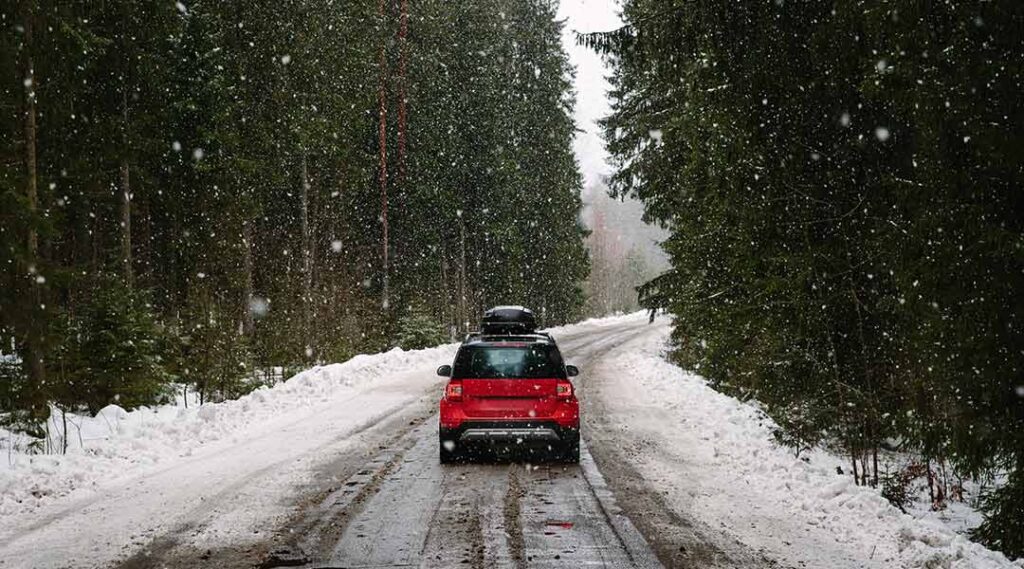This post was originally published on www.progressive.com
Cold-weather driving presents several challenges. Driving in snow may be the most significant one. Driving in snow increases the risk of accidents and exposes you to more dangers than warmer weather. Fortunately, preparing your car and learning how to safely drive in snow and ice can keep you safe.
How do I prepare my car for driving in the snow?
Preparing your car for winter weather is one of the most important ways to stay safe during the winter driving season. Before temperatures get too cold is the best time to get your car winterized. Winterizing your vehicle includes a general checkup of the car’s fluids, battery, hoses, lights, brakes, and exhaust systems. Winter weather — especially extreme winter weather — can apply extra stress to many automotive systems while simultaneously increasing the possibility of a malfunction. Get a trusted mechanic to give your car a winter checkup and then make repairs and change fluids before the winter season starts.
Consider getting winter tires, especially if you live in an area that expects a lot of snow. Winter tires are made of a different, softer type of rubber and have different tread patterns. The tread and rubber formulations give winter tires more flexibility and an increased grip in cold weather (usually below 45 degrees). You can generally identify winter tires by the three-peak mountain snowflake symbol stamped on the side.
You’ll see improved performance and more secure driving with winter tires, but they can be too soft once temperatures heat up again. For this reason, you will need to swap them out at the end of the season. Learn more about tires for different season of driving.
How do I drive in snow and ice?
Safe snow driving starts in the driveway. Before you hit the road, clear the windshield of ice, and brush any snow off the hood of the vehicle. Failing to adequately clear snow from the car can cause problems once you start driving, including blowing snow onto the windshield and interfering with the defroster.
When driving in the snow, allow extra travel time. You can’t move as fast when conditions are snowy or icy, so plan to avoid rushed driving. Once you’re on the road, practice these defensive driving habits and avoid aggressive driving.
Avoid sudden braking or acceleration
You have less traction in the snow than you would on a warm, dry road surface, and sudden movements are more likely to cause the car to lose its grip.
Allow more following distance
Try to drive more cautiously around other drivers and take actions sooner. For instance, if you see brake lights ahead, start slowing down earlier and more gently than you normally would.
Stay calm if you lose control of the car
Take your foot off the accelerator without aggressive braking and steer in the direction of the skid until you feel the vehicle regain traction. If you don’t have the time or space to do so and your car has anti-lock brakes (as most modern cars do), press hard on the brakes. The pedal will shake — an indication that the ABS system is working — but don’t ease up. A computer in the car’s braking system will adjust the brake force to help maximize traction and get things back under control. You can still steer while this is happening, so do your best to avoid hitting anything until the vehicle either stops or regains its grip on the road.
A skid or other loss of control can be scary when driving in snow and ice, but panicking doesn’t help. If you’re new to winter driving, consider practicing in an empty parking lot when the snow and ice hit. Getting acquainted with the behavior of your car on snowy or icy roads can help you stay calm and avoid winter weather accidents.
Emergency kit for winter driving
In addition to preparing your car for winter weather and learning how to drive in the snow, you should also prepare for emergencies. It’s easier to get in an accident or become stranded during the winter, so you should have an emergency kit in your car at all times.
Common items to include in a winter emergency kit include:
- Blankets
- A flashlight with extra batteries
- Sand, salt, or non-clumping cat litter as a traction aid
- A brightly colored bandana, scarf, or flag (preferably red)
- Jumper cables
- A towing chain
- A small snow shovel
- An ice scraper
Some of these items (cat litter, jumper cables, shovel, etc.) can help you move your car if it’s stuck in the snow or unable to start, while others (bandana, blankets, flashlight) help keep you warm and visible for rescuers if you’ve had a crash or are unable to get your car moving.
Along with a heavy snowfall comes the snowplows that keep the roads clear for motorists. Learn more about snowplow safety in winter driving conditions.
[ad_1]
